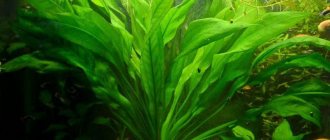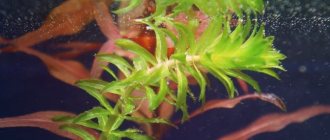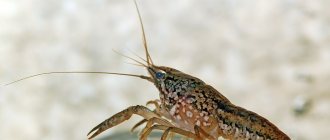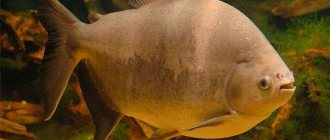Origin: Thailand, Southeast Asia
Dimensions: 3-20cm, can cover the ground.
Lighting: preferably strong
Growth rate: average
Water parameters: temperature 17-28 0C, dH does not matter, pH 6-8.5
Other names: asterisk
note: loves an “adult” aquarium.
Pogostemon Helfera is a very beautiful and spectacular aquarium plant. The ruffled leaves radiate from the rosette stem like the rays of a star. In the right conditions for this plant and under strong light, Pogostemon produces many side shoots that can form an impressive clearing-cap in the foreground or middle ground of the aquarium.
This plant was discovered in the rivers of Thailand, near the border with Burma. In nature, Pogostemon helfera grows on the border of a watershed: both in the air and under water.
Many sources call this plant “complex”, but I would rather call it “capricious”. Recently, I have acquired a sufficient amount of experience in growing this plant in various conditions (I really like experimenting with aquariums). In this article I will try to collect this experience and show why exactly Pogostemon Helfera is a “capricious” and not a “complex” plant.
Description and homeland
Pogostemon helperi is a South Asian plant. The first specimens were discovered in Burma and Thailand. Local residents nicknamed him Daona, which means “little star.” Capricious.
To maintain it, a number of factors are observed:
- bright lighting;
- temperature +22…+28 °C;
- pH.
The limits of water hardness and acidity have a wide range. This will have no effect on Helferi. He quickly adapts to his environment. But it does not tolerate changing conditions well.
The aquarium chosen is one that is active and populated. When planting in a new one, there is a risk that the plant will not take root.
Plant photo gallery:
Compatibility
Unfortunately, it is not possible to keep the fragile starfish in containers with herbivorous fish and snails - most of these aquatic inhabitants will like it.
Daneos, neons, small characins, and poeciliids will be good neighbors for helfera. The need for intense lighting makes Pogostemon an inconvenient neighbor for fish that prefer twilight, that is, for almost all representatives of catfish, except, perhaps, the Julia corydoras and glass catfish.
Landing Features
Before planting the pogostemon in the aquarium, the roots are cleaned of old soil and the leaves are straightened. The plant is planted loosely, as it grows quickly thanks to its side shoots. When choosing a location, it is recommended to give preference to the foreground so that the lighting is bright enough.
Before disembarking, the helferi is inspected. A healthy one will have white, well-branched roots.
The leaves of the star are fragile, so be careful when planting. Don't be alarmed if they turn yellow and fly around. The plant takes root in a new place within three to five weeks, and fresh shoots appear.
Natural habitat conditions
Pogostemon helferi came to us from Thailand. In their natural habitat, these green bushes grow on the banks of rivers and streams located at an altitude of 100 meters above sea level. The water temperature in the rivers does not depend on the season and is about 20°C. The plant develops well both in direct sunlight and in the shade of trees.
Helfera grows at the very edge of the water and during drought, when the rivers become shallow, it is exposed to the air. Therefore, the plant has adapted to life in both humid and airy environments.
INTERESTING: The leaves of this pogostemon radiate from the center like the rays of a beautiful green star blooming near a pond. Therefore, the people of Thailand affectionately call this plant “little star”.
Return to content
Top dressing
Regular fertilization affects growth and development. Fertilizer is applied at the root, into the soil. This helps strengthen and develop the root system. This is how it reproduces naturally.
With a lack of nutrients, the color fades and turns white. If green has replaced a dirty yellow tint, there is no reason to worry. This color is typical for adult plants.
In order to return the leaves to their beautiful emerald color, potassium should be added to the fertilizer.
Reproduction
For rapid development, bushes need root feeding. Regular application of fertilizers to the soil not only nourishes the pogostemon, but also helps to develop a powerful root system. A lack of minerals is indicated by paleness of the stem and leaves. But there is no need to be afraid of a brownish-yellow tint. For adult plants this is the norm. If you want the leaves to be green, double the amount of potassium in the fertilizer.
In the right conditions, the plant quickly forms side shoots and grows. Shoots in silted soil take root easily - this is how pogostemon reproduces. If you do not want to wait for natural growth, cut off the top of the bush and plant it in the substrate. After some time, the top will turn into a separate full-fledged plant. Side shoots can also be cut off and planted in small groups. Do not forget that the average height of a pogostemon is 6 cm; if the stem is excessively extended, it should be trimmed. The wavy leaves look especially attractive on a carpet of Hemianthus cubes or glossostigma. An interesting composition is where lush bushes are combined with stones and driftwood of unusual shapes. Pogostemon feels good not only in an aquarium, but also in a humid palludarium.
Keeping in an aquarium
Nutrients reach the pogostemon through the root system, so the soil chosen is silty and nutritious.
The optimal temperature is maintained within +23…+25 °C; in aquariums with tropical animals and vegetation it can reach +30 °C. In the natural environment it is capable of growing and developing at +20 °C.
The brightness and beauty of Helfery's color is influenced by two factors: lighting and carbon dioxide. The light should be as bright as possible (0.6-1 W/l). CO2 supply within normal limits varies from 7 to 14 mg/l.
Features of growth and development
Pogostemon helfera is a compact plant that reaches a height of 5-6 cm and a width of 5-10 cm. The plant has elongated corrugated leaves that form a rosette of bright green color. The plant is graceful, fragile, growing, forming beautiful thickets. The growth rate is average.
Under normal conditions, helfera becomes lush and relatively large. Over time, the lower leaves of the bush die, and the stem near the ground bends and lies on its side. After some time, roots and new bushes begin to grow from the stem, forming beautiful emerald thickets.
Return to content
Diseases
It suffers from pogostemona if not properly cared for.
| Symptoms / Manifestation on leaves | Cause | Corrective measures |
| They turn yellow. | Insufficient feeding. | Increase the amount of feeding, often feed regularly. |
| They take on an elongated shape, turn pale, and the shade changes to a dirty, swampy one. | Little light. | Add artificial lighting. |
| They dry out and fall off. There are no new shoots, growth slows down. | Lack of nitrogen. | Choose feed with a high content of nitrogen compounds. |
Pogostemon Helfera - the eastern star of aquarium design
Pogostemon Helfera is considered an attractive aquatic plant due to its spectacular appearance. Its rosette is made up of wavy leaves. They are arranged in the shape of a star, due to which pogostemon received the corresponding name Daona in Asia. "Little Star" can be used as a ground cover plant. If suitable conditions are created for this rather demanding pogostemon, it produces a large number of lateral shoots and creates a smooth green meadow. On average, they live 2-3 years.
Spreading
The main habitats of Pogostemon helferi are Southeast Asia, Oceania and Africa. Under natural conditions, one part of the plant is in the air and the other in water. Therefore, it can be grown not only in aquariums, but also in humid palludariums. Pogostemon Helfera was found in rivers in Thailand near the border with Burma.
Growing and care
Since Pogostemon grows small under normal conditions, it can be planted in small aquariums.
However, in a large container he will feel more comfortable. Over time, helperi grows and occupies more and more area, rooting its sprouts in the substrate. The plant is considered quite difficult to breed. However, experienced aquarists speak of it rather as a capricious aquarium inhabitant.
Pogostemon helferi can grow in water with varying levels of hardness, acidity and temperature. At the same time, he cannot tolerate sudden changes in conditions.
Experienced aquarists do not recommend planting Pogostemon in a new aquarium that is just beginning to be formed. The first time after launch, the water in the container will be unstable, which can soon lead to the death of the plant. It is best to plant helferi in an aquarium with an established ecosystem.
Water parameters for ideal maintenance
Indicators of water suitable for growing Pogostemon helferi have a fairly wide range.
- The permissible water temperature is from 22 to 28 degrees Celsius. The recommended range is 23-25ºС.
- Permissible carbonate hardness is from 5º to 10º. Recommended value 4º.
- The permissible total hardness is from 1º to 30º. The recommended corridor is 8-15º.
- Acceptable acid-base balance pH values are from 6 to 7.5. The recommended value is 7.
The presence of dirt in the aquarium is unacceptable. Covering a tropical plant, a mud coating forms mucus. As a result, gas exchange becomes difficult, and various diseases develop. The best solution to the cleaning issue is to install a very powerful filter.
Replacing part of the volume of water can lead to a strong change in its composition, which will negatively affect the plant. This is why it is difficult for beginners to care for pogostemon. Due to inexperience, you can replace too much liquid.
Lighting requirements
The tropical aquatic plant requires a lot of light.
On average, it is necessary to create a light flow with an intensity of 0.5-1 W/l. It is recommended to install diode or fluorescent lamps as a lighting source. If the light is too low, the leaves of Pogostemon helferi begin to stretch and become very weak. Excessive light is also undesirable. It causes increased proliferation of algae, after which the plant most likely dies.
Requirements for soil, nutrient substrate
Aquarists sometimes place fine-grained granite or pebbles or sand from the river on the bottom. However, the best option would be to use a special nutrient soil. They differ in the amount of nutrients and are divided into brands for professionals and beginners. Nutrient pads can also be used.
Fine grain granite
Pebbles
Sand
Both macroelements and microelements can predominate in the composition of the substrate.
Nutrient soil is also important for pogostemon because it normalizes and stabilizes the water condition.
When choosing soil, you need to take into account that in its natural habitat the plant is partially above the water during periods of drought. For this reason, Pogostemon helferi is quite voracious. It requires a very nutritious substrate. Even better is the presence of sludge that forms in long-neglected aquariums.
When purchasing special soil, you should check it for the presence of limestone. To do this, just drop acetic acid onto the granules. The characteristic reaction shows that the soil contains carbonates and polycarbonates, which increase the pH when dissolved in water. Such a substrate will not suit Pogostemon.
ADA Power Sand Special
Dennerle DeponitMix
The best nutrient soils are ADA Power Sand Special and Dennerle DeponitMix. The first uses nutrient particles made from volcanic stone, which have a porous structure. It is recommended to use it as a substrate.
The root system of the pogostemon is pressed down with basic neutral soil. Dennerle DeponitMix contains soil, peat, clay and a large amount of iron. In nature, Pogostemon helferi prefers water bodies with soil saturated with iron and calcium carbonate.
Requirement for fertilizers
The plant has powerful roots that need to be supported with appropriate fertilizers - tablets, granules or capsules. First of all, you will need to feed with microelements. Special attention should be paid to potassium if you need to preserve the bright green color of the pogostemon.
In its normal state, the plant acquires a yellowish-brown color over time. This manifestation is normal and is not a sign of disease. To maintain the emerald hue of the leaves, you will need to fertilize with potassium in double doses.
When choosing fertilizers, it is worth considering that excess phosphates and nitrates negatively affect the condition of Pogostemon helferi. It is recommended to check the number of these connections using tests.
The maximum permissible concentration is:
- PO4 - 0.2 mg/l;
- NO3 - 10 mg/l.
When applying fertilizer to the soil, you need to handle the roots carefully, as they are easily damaged.
Fertilizing should be done once a week. The maximum break between applying fertilizer is 9 days. Otherwise, the plant will begin to turn yellow due to a lack of microelements and vitamins.
Be sure to enrich the water with carbon dioxide at a rate of 6-14 mg/l. In the absence of CO2, the leaves of Pogostemon become thinner, become almost transparent and begin to die.
Reproduction
If suitable conditions are created in the aquarium for the growth of healthy pogostemon, it begins to grow to the sides with new shoots. The latter take root in the soil if there is a sufficient amount of silt.
Another way to get a new plant is to cut off the top of the plant and plant it separately so that the leaves take root. Or you can use side shoots for this.
The average normal height of the plant is 6 cm. If the plant stretches more, it will need to be trimmed.
Variations and forms of the plant
Pogostemon Helferi Red
A rare representative of Pogostemon helferi is Pogostemon Helferi Red. Its young leaves have a characteristic red tint, in contrast to the green tint of the mature foliage.
At the same time, from the general genus Pogostemonaceae, five other species have gained popularity among aquarists:
Yatabeanus
Distributed in China and Korea. It is valuable for aquarists because it can bloom at home, forming several lilac inflorescences.
Stelatus
This representative of the genus Pogostemon is suitable for breeding in large aquariums up to 200 liters. Formed from narrow and long leaves.
Erectus
Also a background plant. It grows up to 40 cm in height, up to 15 cm in width. It needs to be pruned regularly, since this pogostemon grows quickly.
Kimberly
Its leaves are distinguished by serrated edges and beautiful colors. A lush plant is often used by designers as a central element of a plant composition or as a side design element.
Octopus
This plant reaches 60 cm in length and 20-25 cm in width. Planted in the background of the aquarium. The shoots are thin, densely covered with foliage.
Lifehacks and tips for aquarists
Tip #1
Owners of Pogostemon helferi advise carefully selecting its “neighbors” in the aquarium. Due to the soft structure of the leaves, it becomes a tasty food for herbivorous fish and snails.
Neighborhood with the following representatives of aquatic fauna will be good:
- neons;
- catfish with the exception of glass and Julia's corridors;
- Poeciliidae;
- zebrafish;
- small characins.
The proximity of pogostemon with shrimp will be useful. Arthropods clean the surface of the plant from dirt, supporting its metabolic processes.
Tip #2
Experienced aquarists identify several signs of a diseased state of the plant and ways to eliminate them:
Pogostemon helfera stops growing and does not produce new shoots. This is a direct consequence of a lack of nitrogen and nitrogenous compounds. Urgent feeding with fertilizers with appropriate nutrients is required.- The leaves begin to acquire a pronounced yellow color. These changes occur with a general lack of nutrients. In this case, the amount of fertilizing increases, and the time gaps between the introduction of fertilizer decrease.
- Excessive growth and unhealthy color. A swampy tint, pale leaves, as well as excessive stretching of the plant upward means an acute lack of light. To correct the situation, it is enough to increase the lighting.
Tip #3
Do not be alarmed if the plant loses almost all its leaves soon after planting. Since the pogostemon takes root in a new place, such a reaction is normal. On average, after a month, under the right conditions, new beautiful green leaves appear.
Appearance
In appearance, this is a very attractive plant and is mainly planted in the foreground of the bottom of the aquarium. It is a near-root rosette, which is formed by long, wavy leaves at the edges. The color of the leaves directly depends on the light. In the constant presence of intense light, the leaves acquire a bright green color. If the lighting is at semi-darkness, the leaves become dull olive.
Under satisfactory environmental conditions, pogostemon grows intensively due to newly formed rosettes that take root in the ground. In this way, it is possible to completely fill the free space at the bottom of the aquarium.
Important! Pogostemon should not grow more than 10 cm in height. If he has exceeded this mark in his growth and continues to grow, this means that he does not have enough light.











